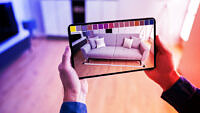Added value or gimmick? Augmented reality in e-commerce
Touching things, trying them on and trying them out, taking them with you there and then – these are experiences that online retail has yet to offer its customers. Does augmented reality help e-commerce to offer at least as good a CX as in-store retail?

Can augmented reality make e-commerce more attractive?
E-commerce has so far been a success story. Sales figures are rising steadily, its share of total sales from all trade channels is growing – but this is slowing down and for many product groups has remained at a relatively low level.
Online purchases accounted for 10.8% of retail sales in 2019 (Source: HDE Online-Monitor 2019).
The question of what the in-store retail trade could do better to counteract the trend towards online trade is much discussed. But the inverse question must also be asked: What can online retail do to enable a shopping experience for all the senses, like that offered by stores? This is where augmented reality comes into play, which, among other things, enables a visualization of the goods offered in the online shop.
Traditional retail buyers and selective online shoppers have strong reservations about buying certain products or groups of products online. The reasons most frequently cited for preferring stores are:
#1: The possibility to try on and try out products
#2: Personal advice and individually tailored product recommendations
#3: No need to disclose data and become a “transparent customer”
#4: Shopping as an event that you experience together with friends or family
#5: Personal interaction with people
What can augmented reality do in e-commerce?
Although Pokémon Go was the first time that mainstream consumers became familiar with augmented reality, in e-commerce it can be more than just a gimmick. AR can help e-commerce
- to put reservations about online shopping into perspective, to eliminate counterarguments.
- to enrich online shopping with experiences that were previously reserved exclusively for shopping in stores.
- to open up opportunities that neither traditional e-commerce nor retail could offer, as they are virtually impossible to implement in reality.
Augmented reality has long since arrived in the e-commerce mainstream and is proving useful in many respects. Thanks to Apple’s “ARKit” and Android’s “ARcore”, creating AR apps is no longer a challenge for developers. Shopify offers its customers the possibility to fit out their online shops with module-based AR functionality.
Use cases: Augmented reality in e-commerce
The following examples give an overview of how augmented reality is currently used in e-commerce. So far, AR apps mainly aim to eliminate the first two arguments against online shopping in the list above.
Ikea

Ikea furnishes its customers’ homes virtually with the AR app “Ikea Place”. Being able to set up virtual furniture before you buy it offers many advantages. You can see at a glance whether the size, color and style fit. Different furnishing variations can be tried out easily before purchase and the customer puts a great deal of thought into the product. This reduces the likelihood that they will need to make an inconvenient exchange after a purchase.
For the furniture giant, this means fewer returns and fewer costs associated with these. In addition, the app offers the opportunity to cleverly place further product recommendations and alternatives while the customer feels excellently advised. This increases the conversion rate and would not be feasible in a brick-and-mortar furniture store.
With the app “yourhome”, Otto has long since followed suit and also offers the possibility of virtually positioning the product range within your own four walls before buying.
Mister Spex
The first advertising campaign that brought augmented reality in connection with e-commerce to the attention of the general public in Germany was probably Mister Spex with its online glasses shop offering the chance to try on the available models virtually.
Amazon
The “Amazon AR View” feature on the Amazon app allows you to virtually place certain products, such as furniture or electrical goods, in your home before buying them, much like “IKEA Place”.
With a mixed reality mirror patented by Amazon, customers can virtually try on clothes. A display located behind the mirror shines through the mirror surface, so that it presents a mixed reality of reflection and digital projection. The advantage of this variant over actually trying on clothes is that it is much faster. You can try on completely different outfits of different styles in just a few minutes. So far, however, this product has yet to enjoy a breakthrough. One possible reason is that it fails to offer one of the main purposes of trying on clothes: to find out whether the clothes are comfortable to wear and whether the size and shape really fit your body.
Zara
Zara chose a different approach with its “Zara AR” app. Rather than enabling the customer to try on clothes virtually, the app lets famous models showcase the collection when the customer points their smartphone at the clothes on display. This makes fashion more tangible, more real, and the customer can imagine how the garment will look on the body in motion.
But the customer cannot tell how the item would look on their own body. All in all, the effect is the same as playing an advertisement on demand – but with a direct link to the online shopping cart.
Dulux
AR offers some advantages in online retail that would not be possible even in in-store retail, or only at huge expense. For example, customers can simulate painting their own four walls using the app from paint manufacturer Dulux. A color sample or a painted test area in a shop or DIY store does not come close to this effect.
Where augmented reality reaches its limits
Finding out how products feel is a customer wish that cannot yet be met by e-commerce. Amazon is trying to close this gap by opening pop-up stores where customers can view, touch and order products online by scanning a code. But this solution is not practical or even feasible for the vast majority of e-commerce companies.
Even augmented reality will not be able to offer a satisfactory solution for this drawback in the foreseeable future. Sitting on a sofa that has been virtually projected into your living room at home may prove just as difficult as choosing a suitable mattress using an AR simulation. Off-the-shelf augmented reality applications – they are now available as such in shop modules for online stores, and many of the augmented reality apps are just as uniform in terms of their possibilities.
An AR-supported online shop does not make sense for every product group. No one, for example, would seriously consider putting a virtual broccoli in their refrigerator – we would simply order a natural original. And there is no point presenting a perfume bottle in a showroom customer bathroom if the fragrance of its contents cannot be simulated.
A complex 3D visualization therefore makes particular sense for:
- Higher-priced products
- Products with larger dimensions
- Goods where haptic, gustatory and olfactory perception are irrelevant to the purchase decision
However, an augmented reality visualization can easily be extended by an acoustic dimension, so an online shop for musical instruments, for example, can benefit greatly from the technology.
Conclusion: Lots of potential, lots of room for improvement
AR applications are still a very broad testing ground. Many things are possible, some are being tried out with development efforts, some are proving useful, while some are a gimmick without any real added value. For an AR concept and an AR app to make sense, it must offer both parties, the company and above all the customer, significant added value compared to shopping in a retail store.
So far, AR applications lack opportunities for interaction and the experience factor. There are just as many approaches for AR applications in social media and messenger services as there are in print and outdoor advertising. However, AR has yet to receive much attention in marketing. Fresh input and new ideas are promised by the phenomenon video triggered AR, which enables interactive product placement in films and TV series. Advancements in spatial computing will considerably expand the possibilities and fields of application of AR in the medium term – also in e-commerce.





